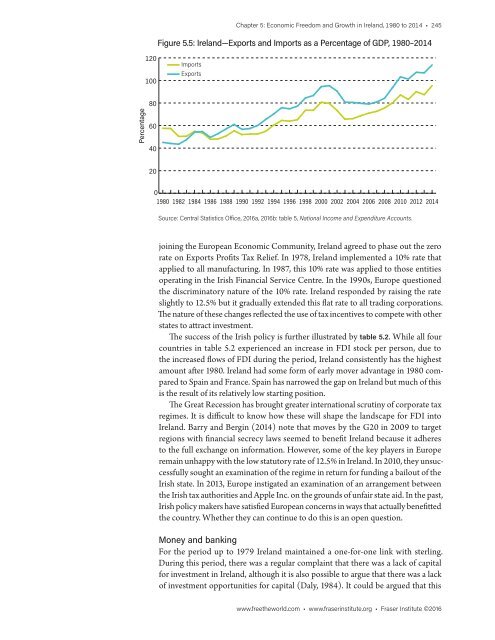Economic Freedom of the World
economic-freedom-of-the-world-2016
economic-freedom-of-the-world-2016
Create successful ePaper yourself
Turn your PDF publications into a flip-book with our unique Google optimized e-Paper software.
Chapter 5: <strong>Economic</strong> <strong>Freedom</strong> and Growth in Ireland, 1980 to 2014 • 245<br />
Figure 5.5: Ireland—Exports and Imports as a Percentage <strong>of</strong> GDP, 1980–2014<br />
120<br />
100<br />
Imports<br />
Exports<br />
80<br />
Percentage<br />
60<br />
40<br />
20<br />
0<br />
1980<br />
1982<br />
1984<br />
1986<br />
1988<br />
1990<br />
1992<br />
1994<br />
1996<br />
1998<br />
2000<br />
2002<br />
2004<br />
2006<br />
2008<br />
2010<br />
2012<br />
2014<br />
Source: Central Statistics Office, 2016a, 2016b: table 5, National Income and Expenditure Accounts.<br />
joining <strong>the</strong> European <strong>Economic</strong> Community, Ireland agreed to phase out <strong>the</strong> zero<br />
rate on Exports Pr<strong>of</strong>its Tax Relief. In 1978, Ireland implemented a 10% rate that<br />
applied to all manufacturing. In 1987, this 10% rate was applied to those entities<br />
operating in <strong>the</strong> Irish Financial Service Centre. In <strong>the</strong> 1990s, Europe questioned<br />
<strong>the</strong> discriminatory nature <strong>of</strong> <strong>the</strong> 10% rate. Ireland responded by raising <strong>the</strong> rate<br />
slightly to 12.5% but it gradually extended this flat rate to all trading corporations.<br />
The nature <strong>of</strong> <strong>the</strong>se changes reflected <strong>the</strong> use <strong>of</strong> tax incentives to compete with o<strong>the</strong>r<br />
states to attract investment.<br />
The success <strong>of</strong> <strong>the</strong> Irish policy is fur<strong>the</strong>r illustrated by table 5.2. While all four<br />
countries in table 5.2 experienced an increase in FDI stock per person, due to<br />
<strong>the</strong> increased flows <strong>of</strong> FDI during <strong>the</strong> period, Ireland consistently has <strong>the</strong> highest<br />
amount after 1980. Ireland had some form <strong>of</strong> early mover advantage in 1980 compared<br />
to Spain and France. Spain has narrowed <strong>the</strong> gap on Ireland but much <strong>of</strong> this<br />
is <strong>the</strong> result <strong>of</strong> its relatively low starting position.<br />
The Great Recession has brought greater international scrutiny <strong>of</strong> corporate tax<br />
regimes. It is difficult to know how <strong>the</strong>se will shape <strong>the</strong> landscape for FDI into<br />
Ireland. Barry and Bergin (2014) note that moves by <strong>the</strong> G20 in 2009 to target<br />
regions with financial secrecy laws seemed to benefit Ireland because it adheres<br />
to <strong>the</strong> full exchange on information. However, some <strong>of</strong> <strong>the</strong> key players in Europe<br />
remain unhappy with <strong>the</strong> low statutory rate <strong>of</strong> 12.5% in Ireland. In 2010, <strong>the</strong>y unsuccessfully<br />
sought an examination <strong>of</strong> <strong>the</strong> regime in return for funding a bailout <strong>of</strong> <strong>the</strong><br />
Irish state. In 2013, Europe instigated an examination <strong>of</strong> an arrangement between<br />
<strong>the</strong> Irish tax authorities and Apple Inc. on <strong>the</strong> grounds <strong>of</strong> unfair state aid. In <strong>the</strong> past,<br />
Irish policy makers have satisfied European concerns in ways that actually benefitted<br />
<strong>the</strong> country. Whe<strong>the</strong>r <strong>the</strong>y can continue to do this is an open question.<br />
Money and banking<br />
For <strong>the</strong> period up to 1979 Ireland maintained a one-for-one link with sterling.<br />
During this period, <strong>the</strong>re was a regular complaint that <strong>the</strong>re was a lack <strong>of</strong> capital<br />
for investment in Ireland, although it is also possible to argue that <strong>the</strong>re was a lack<br />
<strong>of</strong> investment opportunities for capital (Daly, 1984). It could be argued that this<br />
www.free<strong>the</strong>world.com • www.fraserinstitute.org • Fraser Institute ©2016


